Cecidomyiidae
| Cecidomyiidae | |
|---|---|
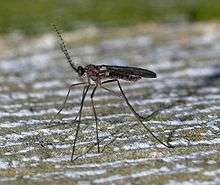 | |
| Scientific classification | |
| Kingdom: | Animalia |
| Phylum: | Arthropoda |
| Class: | Insecta |
| Order: | Diptera |
| Suborder: | Nematocera |
| Infraorder: | Bibionomorpha |
| Superfamily: | Sciaroidea |
| Family: | Cecidomyiidae |
| Subfamilies | |
| |
| Synonyms | |
| |
The Cecidomyiidae (sometimes spelled Cecidomyidae[1]) are a family of flies (order Diptera) known as gall midges or gall gnats. As the name implies, the larvae of most gall midges feed within plant tissue, creating abnormal plant growths called galls.
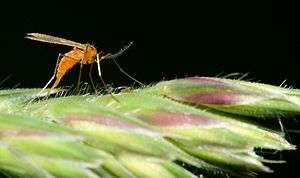
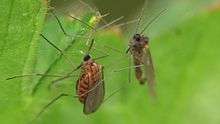
Cecidomyiidae are very fragile small insects usually only 2–3 mm in length; many are less than 1 mm long. They are characterised by hairy wings, unusual in the order Diptera, and have long antennae. More than 6,000 species and 783 genera are found worldwide, but since 1,100 are from well-studied North America, this may be an underestimate. [2]
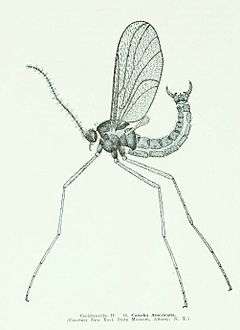
Description
Cecidomiidae are minute to small (0.5-3.0 mm), rarely larger (up to 8 mm, wing length 15 mm) flies with a delicate appearance. Except for a few genera with reduced wings, the eyes are holoptic. The mouthparts are reduced. Cecidomiid antennae are notably long, with 12-14 segments, (sometimes fewer and up to 40 in some genera). The antennal segments either consist of a basal thickening and petiole or they are binodal, with a proximal node, an intermediate petiole and a distal node. Basal, medial, and apical whorls of hairs occur on the antennal segments. In some species, whorls of loop-shaped sensory filaments are also found, the basal or medial one sometimes being reduced. Some gall flies have only one (basal) whorl of hairs on the antennal segments, and the sensoria (transparent sensory appendages) differ in size and shape. The filaments are thread-like in the Porricondylinae and in all the Cecidomyiinae and take the form of long loops in the supertribe Cecidomyiidi). Ocelli are present only in the Lestremiinae. The wings are usually clear, rarely patterned. The wing bears microtrichia, often as scales, and some species have macrotrichia. The number of longitudinal veins is reduced. Only veins R1, R4+5, M3+4 and Cu1 are well developed in most species. The medial veins M1 and M2 are developed only in primitive groups, and the costa usually has a break just beyond vein R5. The legs are long and slender, without apical bristles.
 Catochini wing veins
Catochini wing veins Cecidomyiinae wing veins
Cecidomyiinae wing veins Lasiopterini wing veins
Lasiopterini wing veins Lestremiini wing veins
Lestremiini wing veins Micromyini and Peromyiini wing veins
Micromyini and Peromyiini wing veins_wing_veins.svg.png) Porricondylinae (most) wing veins
Porricondylinae (most) wing veins Winnertziini wing veins
Winnertziini wing veins
The genitalia of males consist of gonocoxites, gonostyles, aedeagus, and tergites 9 and 10. Lower (in the evolutonary sense) gall flies often have sclerotized parameres and a more or less transparent plate (the tegmen) located above theaedeagus-the tegmen. In higher gall flies, the parameres and tegmen are not developed. In these, instead, close to the aedeagus, is a triangular basal outgrowth of the gonocoxites called the gonosterna. Supporting structures called apodema are located near the base of the genitalia in males; these are often equipped with two outgrowths. The ovipositor is short, lamelliform, or long, mobile, and in some species, acicular.
The larva is peripneustic. The head is tiny, cone-shaped, and has two posterolateral extensions. The mouthparts are reduced, with minute styliform mandibles. The relatively prominent antennae are two-segmented. Integumental setae or papillae are important in taxonomy since they are constant in number within groups. The prothorax has sclerotized sternal spatula (most). The anus is terminal in the Lestremiinae and paedogenetic in the Porricondylinae and ventral in other groups. The pupa is exarate (in a few species it is enclosed within the last instar larval integument). The anterior spiracle and anterior angle of antennal bases is prominent (most).[3] [4]
.jpg)
Biology
Many are economically significant, especially the Hessian fly, a wheat pest, as the galls cause severe damage. Other important pests of this family are the wheat blossom midge Sitodiplosis mosellana, the asian rice gall midge (Orseolia oryzae) and the African rice gall midge O. oryzivora. Other pests are the coffee flower midge (Dasyneura coffeae), Soybean pod gall midge, (Asphondylia yushimai) pine needle gall midge (Thecodiplosis japonensis), the lentil flower midge (Contarinia lentis), the lucerne flower midge (C. medicaginis), and the alfalfa sprout midge (Dasineura ignorata) on the Leguminosae; the black locust tree gall midge (Obolodiplosis robiniae), the swede midge (Contarinia nasturtii), and the brassica pod midge (Dasineura brassicae) on the Cruciferae; the pear midge (Contarinia pyrivora) and the raspberry cane midge (Resseliella theobaldi) on fruit crops; Horidiplosis ficifolii on ornamental figs, and the rosette gall midge (Rhopalomyia solidaginis) on goldenrod stalks, Porrcondylini spp. on Citrus, Lestremia spp. on sweet potato, yam, ginger, garlic, onions, taro tubers, and potato, Lestodiplosis spp., Acaroletes spp., and Aphidoletes spp. on oranges, Lestodiplosis spp., Acaroletes spp., and Aphidoletes spp. on oranges, and Arthrocnodax spp. on limes. [5] [6] [7]
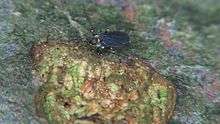
A large number of species are natural enemies of other crop pests. Their larvae are predatory, and some are even reported as parasitoids. The most common are aphids and spider mites, followed by scale insects, then other small prey such as whiteflies and thrips, which eat the eggs of other insects or mites. As the larvae are incapable of moving considerable distances, a substantial population of prey must be present before the adults lay eggs, and the Cecidiomyiidae are most frequently seen during pest outbreaks. One species, Aphidoletes aphidomyza, is an important component of biological control programs for greenhouse crops and is widely sold in the United States. In South Africa, Dasineura rubiformis has been deployed against invasive Australian Acacia species.
The Cecidomyiidae are also known for the strange phenomenon of paedogenesis in which the larval stage reproduces without maturing first. In some species, the daughter larvae consume the mother, while in others, reproduction occurs later on in the egg or pupa.[8]
Parasitoids hosted by the Cecidomyiidae, thereby limiting the gall midge population include the Braconidae (Opiinae, Euphorinae) and chalcidoid wasps in the families Eurytomidae, Eulophidae, Torymidae, Pteromalidae, Eupelmidae, Trichogrammatidae, and Aphelinidae. All contain species which are actual or potential biolological agents.
See also
References
- ↑ University of California, Riverside
- ↑ Raymond J Gagné , 2004 A catalog of the Cecidomyiidae (Diptera) of the world Entomological Society of Washington Issue 25
- ↑ Gagné, R. J. 1981. Cecidomyiidae. In: McAlpine, J. F. et al. (eds.), Manual of Nearctic Diptera. Vol. 1. Research Branch, Agriculture, Canada, Ottawa. pp. 257-292. download here
- ↑ Mamaev, B.M. Family Cecidomyiidae in Bei-Bienko, G. Ya, 1988 Keys to the insects of the European Part of the USSR Volume 5 (Diptera) Part 2 English edition.Keys to Palaearctic species but now needs revision.
- ↑ Darvas, B., Skuhravá, M., Andersen, A., 2000, Agricultural dipteran pests of the Palaearctic Region. In: Papp, L., Darvas, B. (Eds.). Contributions to a Manual of Palaearctic Diptera with Special Reference to Flies of Economic Importance. Science Herald, Bupapest, 565-649.
- ↑ Dennis S. Hill, 1987 Agricultural insect pests of temperate regions and their control Cambridge [Cambridgeshire] ; New York : Cambridge University Press, 1987.ISBN 0521240131
- ↑ Dennis S Hill 1987 Agricultural Insect Pests of tropics and their control Cambridge. University Press , New York ISBN 9780521294416
- ↑ Wyatt, I.J. 1961. Pupal paedogenesis in the Cecidomyiidae (Diptera).–I. Proceedings of the Royal Entomological Society of London (A) 36: 133-143.
Further reading
Economic
- Barnes, H.F. 1946a. Gall midges of economic importance. Vol. I: gall midges of root and vegetable crops. Crosby Lockwood & Son Ltd., London.
- Barnes, H.F. 1946b. Gall midges of economic importance. Vol. II: gall midges of fodder crops. Crosby Lockwood & Son Ltd., London.
- Barnes, H.F. 1948a. Gall midges of economic importance. Vol. III: gall midges of fruit. Crosby Lockwood & Son Ltd., London.
- Barnes, H.F. 1948b. Gall midges of economic importance. Vol. IV: gall midges of ornamental plants and shrubs. Crosby Lockwood & Son Ltd., London.
- Barnes, H.F. 1949. Gall midges of economic importance. Vol. VI: gall midges of miscellaneous crops. Crosby Lockwood & Son Ltd., London.
- Barnes, H.F. 1951. Gall midges of economic importance. Vol. V: gall midges of trees. Crosby Lockwood & Son Ltd., London.
- Barnes, H.F. 1956. Gall midges of economic importance. Vol. VII: gall midges of cereal crops. Crosby Lockwood & Son Ltd., London. 261 p.
- Nijveldt, W. 1969. Gall midges of economic importance. VIII: gall midges--miscellaneous. Crosby, Lockwood & Son Ltd., London
- Jahn, GC and B. Khiev. 2004. Gall midge in Cambodian lowland rice. pp. 71–76. In J. Benett, JS Bentur, IC Pasula, K. Krishnaiah, [eds]. New approaches to gall midge resistance in rice. Proceedings of the International Workshop, 22–24 November 1998, Hyderabad, India.
- Los Baños (Philippines): International Rice Research Institute and Indian Council of Agricultural Research. 195 p. ISBN 971-22-0198-8
- Heong, KL, YH Chen, DE Johnson, GC Jahn, M Hossain, RS Hamilton. 2005. Debate Over a GM Rice Trial in China. Letters. Science, Vol 310, Issue 5746, 231-233, 14 October 2005.
- Huang, J., Ruifa Hu, Scott Rozelle, Carl Pray. 2005. Insect-Resistant GM Rice in Farmers' Fields: Assessing Productivity and Health Effects in China. Science (29 April 2005) Vol. 308. no. 5722, pp. 688 – 690. doi:10.1126/science.1108972
Taxonomy
- Mohn, E. 1966-1971. Cecidomyiidae (=Itonididae). Cecidomyiinae (part). In: Lindner, E. (Ed.) Die Fliegen der Palaearktischen Region 2(2): 1-248.
- Yukawa, J. (1971) A Revision of the Japanese Gall Midges (Diptera: Cecidomyiidae). Memoirs of the Faculty of Agriculture, Kagoshima University 8: 1-203.pdf
External links
| Wikimedia Commons has media related to Cecidomyiidae. |
![]() Data related to Cecidomyiidae at Wikispecies
Data related to Cecidomyiidae at Wikispecies
- Pest Information Wiki
- Diptera.info images
- Family Cecidomyiidae at EOL images
- Family description and images
- Aphidoletes aphidimyza and biological control
- images
- Gall Midge Resistant Lowland Rice Varieties: Glutinous Varieties for the Lao PDR
- Fungus Gnats Online
- African Rice Gall Midge
- on the UF / IFAS Featured Creatures Web site*
- CAB International Invasive species compendium